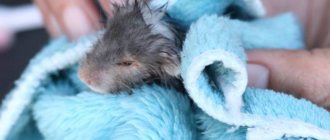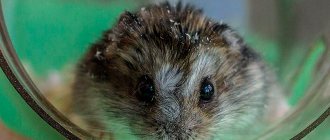- home
- Care
10/20/2018 Like other furry animals, hamsters do a good job of cleaning their fur themselves. They are quite clean, so they lick themselves about 5-6 times a day. But sometimes situations arise when a rodent is unable to clean the fur on its own. In such cases, the owner should be aware of how to bathe hamsters at home.
Do hamsters need to be washed?
Djungarian hamsters are clean and tidy animals. Mother Nature herself instilled in them a love of cleanliness. Every day, cute creatures clean their fur with their paws. Therefore, it is not recommended to wash hamsters frequently, due to the following unpleasant consequences:
- severe stress. A small defenseless pet experiences extreme excitement when it comes into contact with water. The nervous system is overloaded, and the animal’s heart stops;
- hypothermia. Incorrect water temperature and wet wool can cause colds and pneumonia ;
- skin disease. Dermatitis, scratching and purulent wounds appear after using shampoo. The detergent disrupts the acid-base balance of the skin and the protective fat layer. An undried fur coat is a good environment for the development of lichen;
- getting injured. Often a person drops a pet when it is bitten or scratched. Washing under running water allows the rodent to slip out of your hands. He hits himself, gets scared and runs away.
The reason for bathing a dwarf must be serious. For example, a pet is sick and cannot clean its fur on its own.
Important! It is not recommended to follow your own desires and beliefs. It is strictly forbidden to wash your hamster without good reason.
Bath water is very dangerous for hamsters
How to Clean a Hamster Using Cotton Pads or Wipes
The use of napkins is not recommended. They may contain chemicals, including alcohol and fragrances, that can be harmful to rodents. The unnatural odor left behind by the wipes causes stress in animals.
Cotton pads are a neutral option. They are moistened with water and passed over the contaminated area, carefully adjusting the pressure. This method causes less stress for pets who are afraid of classic baths. After the procedure, the wool must be dried to prevent disease due to weakened immunity.
Is it possible to bathe a hamster in water?
A bath of water is a dangerous object for an animal, where it can get stressed and have various complications. But the following situations justify the owners’ intentions regarding the speedy cleansing of the jungarik:
- wool is contaminated with hazardous food products. For example, the hamster got dirty with jam, butter, mayonnaise or other fatty, sticky food. While cleaning its fur, the pet gorge itself on forbidden food . You should immediately wash the animal to prevent poisoning or indigestion;
- household chemicals got on the fur. Acetone, shampoo, floor or dishwashing detergents are more dangerous substances for a tiny organism;
- parasites appeared. Lice, ticks, lice eaters are unpleasant creatures that destroy the life of an animal. For destruction, use medicated shampoo.
Attention! At the first sign of parasites, you should immediately contact your veterinarian. Self-medication is excluded. Only a specialist will conduct a thorough examination and prescribe the optimal treatment.
Sometimes it's worth taking your hamster to the doctor
When can you do without water?
All of these risks must be taken into account when thinking about whether or not you can wash your hamster. The reason for water procedures must be at least serious. In many situations, you can do without soaking your hamster with water:
Smell from the cage
Most often, the source of the smell is not the animal itself, but its habitat. Before washing your pet, you should try to change the bedding more often, and also wash the cage and accessories with soap. The toilet corner is cleaned daily, and a complete change of filler is carried out once a week.
Animals may smell stronger than usual during the heat period. The smell will go away with the end of the heat, just wait a couple of days.
Untidy wool
If the fur looks greasy, dirty, or has feces or pieces of food stuck to it, this is still not a reason to wash your dwarf. A sand bath will effectively clean the coat, leaving it soft and shiny. This bathing suit for your hamster will provide a pleasant pastime and hygiene at the same time.
Local pollution
When a long-haired animal encounters such a problem as chewing gum, candy, or glue getting tangled in its hair, you need to try to cut off the affected area. Owners of Angora hamsters will agree that it is better to sacrifice the beauty of their fur than to bathe Syrian hamsters in water.
Heatstroke
Sometimes owners let the hamster swim, or put it under running cold water with the best of intentions - in order to cool the body as quickly as possible in case the pet gets sunstroke. This is unacceptable; in case of acute overheating, the temperature should decrease gradually. It is permissible to wet only the ears and paws with cool water. The pet should be placed on a tile or ceramic dish and given time to recover. There are many other methods to save the animal from the heat, besides bathing.
Skin diseases
A veterinarian who does not specialize in treating rodents may prescribe bathing with a medicated shampoo as a treatment for parasites or deprivation. This is unjustified, since there are other forms of drugs (injections, spray) that do not put the pet’s life at risk. In such a situation, it would be correct to contact a rodentologist to prescribe treatment.
Pre-exhibition preparation
Owners of long-haired Angoras sometimes argue about whether it is possible to wash the Syrian hamster to make the hair silky and shiny. Bathing is necessary if the hair is contaminated with urine and droppings, but this situation is out of the ordinary. She talks about poor living conditions and rare changes of bedding.
Owners of dwarf shorthaired individuals also ask whether they need to bathe their hamsters if there is a clear odor from the animal. It is necessary, but use sand, not water, for this.
A sand bath is a good way to keep fur in good condition for all types of hamsters. Bathing suits are sold at pet stores, although you can use any container. Djungarik will be happy to lie on his back in such a bath. Syrians bathe differently, rubbing their sides. This is not too much of an expense and is very beneficial for the pet.
Many decorative rodents happily live their lives without water treatments. But it cannot be denied that there are situations in which hamsters can be washed, even necessary. If, through negligence, a pet gets into trouble, the owner will need information on how to bathe a hamster.
How often are hamsters washed?
Your pet needs a bath with warm water once a month to get rid of unpleasant odors. The owner should still remember to regularly change the bedding and clean the cage. This way the animal will always be clean, healthy, and affectionate.
Advice! If a person carefully monitors the condition of the hamster’s home, and the unpleasant odor does not disappear, then it is important to show the pet to a veterinarian. Perhaps the animal is sick.
If the animal is sick, the owner must take into account the recommendations of a specialist. Strictly follow the regime and frequency of bathing.
It is necessary to observe the temperature regime when washing a hamster
How to get rid of dirt without water?
As noted above, the reason for bathing a dwarf must be serious. And in many cases, you can clean your pet without taking a “bath”:
- If you notice an unpleasant odor from the hamster’s habitat, then you should bathe the cage, not the hamster. Partially changing the bedding, thoroughly washing accessories, daily cleaning of the toilet corner - and the unpleasant odor will disappear.
- If the dzhungarika seems dirty and greasy at six, or there are pieces of food or feces stuck to it, then there is no need to take water procedures. Sand baths will help cope with such contaminants.
- If candy, chewing gum or glue is tangled in a dzhungarik's fur, then it is enough to cut off the affected area of fur.
- If a rodent gets dirty with food and cannot deal with the contamination on its own, you can wipe its fur with a damp cloth or cotton swab.
If skin diseases are present, many experienced rodent veterinarians will prescribe medications that do not require washing your pet. For example, sprays and injections.
Bathing a Djungarian hamster in water
What you need for swimming
Experienced breeders recommend providing permanent accessories for the dwarf and storing them in a clean place. Here is a list of required components:
- a shallow bowl or other stable container;
- a cloth, cotton pads, a soft brush for cleaning wool. You can use a toothbrush with very soft hairs;
- special shampoo or soap for rodents;
- 2 towels;
- A hamster's favorite treat to reduce stress.
Advice! It is better to prepare your supplies in advance so that you are not distracted during the bathing process. It is convenient to wash the little animal with four hands: one person holds the furry, and the second does all the work.
How to bathe properly
Bathing a tiny friend is simple, but it will require maximum patience, attentiveness and caution. Here is a step-by-step algorithm:
- Fill a bowl with water at a temperature of at least +22 °C. The depth of the liquid should be 2 cm. If you need to use shampoo or soap, prepare rinsing water at the same temperature in advance;
- Lightly wet the hamster. It is better to place it in a bowl and carefully pour liquid from a glass;
- mix a drop of shampoo with some water and soap the animal. If soap is used, then first lather your hands and gently stroke and massage your pet. The brush will help clean the fur;
- Rinse thoroughly with clean water and dry.
Important! To prevent the hamster from breaking out, scratching or biting, you should hold it firmly in an upright position. Avoid getting water into your ears and eyes.
Drying after swimming
After water procedures, dry the hamster with a cloth or soft towel. Then wrap it in a dry towel and hold it in your hands until it dries completely.
Advice! His favorite treat will help calm him down. It’s funny to watch how the little muzzle, barely visible from the towel, hurriedly gobbles up the goodies.
A hamster may catch a cold
List of necessary components for washing
A bowl
Washing your hamster in the sink is not the best option. It is better if the animal can rest on its paws and not slide too much. A bath for a hamster is any small, stable container.
Fill the bowl with slightly warm water (slightly above room temperature) to 2 cm.
Available means
If you simply rinse the animal with water, running your hands over the body, it is not enough to clean the fur using a cloth or a soft toothbrush. It is convenient to wipe the face, eyes, and anus with cotton pads.
Shampoo without fragrance
Only for special stains (sticky or toxic substances) use detergent. The pet store may not sell a special shampoo for hamsters, but it’s good if you can buy a detergent for washing rodents or rabbits. It is better not to use human products (even for babies): they are intended for a different skin pH.
Hand towel, pet cloth, paper towels
Delicacy
Food rewards can help reduce stress and keep your pet in your arms long enough to dry him off. Juicy or protein food (piece of chicken, fruit) is usually used as a treat. The animal must like the product.
Assistant
In order to bathe a hamster, two people may be required, this is more convenient. Small nimble animals should not be let out of your hands even for a moment. While the owner holds the rodent, the assistant pours water and gives a towel.
Why is washing in water dangerous?
Incorrect, frequent bathing of hamsters results in serious consequences. The main disease of the rodent is hypothermia. The reasons lie in human carelessness and inattention. For example, the hamster got water in its ears or nose, or it was not dried well.
If the animal sneezes often, rubs its nose with its paws, mucous discharge protrudes from the nasal cavity, and the fur around the eyes is wet, then the hamster has a cold. Hypothermia is accompanied by pneumonia. Failure to contact a veterinarian in a timely manner will result in death for the pet, and in regret and bitterness for the person.
Does your hamster have a cold?
Is it possible to eliminate pollution without resorting to bathing with water?
The Djungarians themselves are quite clean creatures and for the most part they do not need human help to cleanse themselves. And yet, once a week you can make sand baths, for which you should use a special container. In the wild, hamsters use just this method of bathing rather than water.
If you notice that there is dirt on the hamster's fur, take a wide brush (a hair coloring brush or an art brush made of dense bristles is suitable) or an ordinary toothbrush. Moisten it a little, gently and slowly move it over the animal’s fur. After finishing the procedure, wipe with a towel. You should not bathe your hamster in water again, as this may make him sick.
What veterinarians say about bathing hamsters
Doctors do not support the owners' desire to regularly wash jungarians. Water for a hamster means stress, the risk of developing dangerous diseases, and getting injured.
But there are such fluffy fidgets who are in no hurry to get out of the warm pool. Here the person is required to be extremely attentive. If a rodent is left alone with household chemicals and cosmetics, then its curiosity will prevail and it will definitely try everything.
Sand baths have many benefits
Alternative to water treatments
Since washing your pet is dangerous and stressful, a hamster bath is a good alternative. By their nature, these animals are very clean, so they themselves are able to clean their fur by tumbling in the sand.
Bathing rods for rodents are sold in pet stores, but you can make them yourself from cardboard, a food container, a soap dish and other available materials. They need to be filled with very fine dry sand, which will have to be changed weekly. It is better not to leave the sandy bathing suit in the cage all the time, because the animal is capable of knocking it over or playing whale there. By the way, pet stores also sell cages with balconies that you can use for a sand bath.
The indisputable advantage of bathing suits is their complete safety. They do not drive the tiny pet into a state of panic, they do not make the fur wet and there is absolutely no chance of catching a cold. Therefore, we advise you to arrange sand baths for the crunch every day, and water baths only in case of emergency.
Now you know whether small rodents like to splash around in water. Considering their cowardice and poor health, give preference to sand baths. But if parasites appear on your pet, wash it carefully and dry it thoroughly with a towel!
Is it possible to wash a hamster in sand?
Wild Djungarian hamsters clean their coats by wallowing in the sand. Therefore, veterinarians recommend performing such procedures on pets, but not more than 2 times a week.
A sand bath has many advantages that are incomparable to water procedures:
- the dzhungarik is not stressed, but enjoys frolicking and bathing in the sand;
- the occurrence of colds and pneumonia is excluded;
- there is no need to dry your pet after the pool;
- sand is a great sporting activity for a tiny fluffy.
Special containers from the pet store will help organize the bathing process. You can use a food container, a deep bowl, a rodent carrier, and so on.
Attention! It is not recommended to overuse sand baths, much less leave the bathing suit in a cage with a dwarf. The animal's skin will dry out and lose its protective properties. An additional unpleasant result will be the constant need for this container. The hamster will do his business and roll around in the soiled mixture.
The sand must be sterile.
Watching an animal bathe in the sand will give the owner a lot of positive emotions. For a hamster, sand procedures are an exciting game where he flounders, digs, and has fun . It is important to remove the remaining sand particles from the animal’s fur after an exciting game. This can be done with a regular toothbrush.
Properly selected sand is a safe bathing environment for your hamster. Bulk material must be:
- sterile. Avoid using river and street sand. The mixtures contain dirt and dangerous microorganisms that cause various diseases. It is better to buy a special sand at a pet store;
- with suitable particle sizes. It is important to choose the “golden mean” here. Material that is too small will get into the hamster’s eyes, ears and respiratory tract, and large material will damage the skin;
- homogeneous. A mixture with sand grains of the same size is an excellent option for bathing;
- clean. The sand is changed before each use, or sifted and calcined in a frying pan.
Advice! There is no sand specifically for Djungarian hamsters in pet stores. Veterinarians recommend purchasing special bulk materials for chinchillas.
But here, during the selection, care and caution are also required. According to reviews from owners and professional breeders, the best sands for swimming are:
- “Vaka” is a budget product from Russia - high-quality and inexpensive sand;
- “Vitakraft chinchilla sandy” - cleanses your pet’s coat well and makes it shiny and healthy;
- “Padovan bathing send” - does not contain fine dust and other foreign impurities.
High-quality sand for bathing will allow the dwarf to be clean, healthy, beautiful and happy. But do not forget about the negative impact of excessive sand procedures.
Rodent hygiene
In general, hamsters know how to take care of their hygiene. They take care of their fur on their own and do not have a specific odor.
In addition, pets go to the toilet only in a certain place, so the litter remains clean for a long time. There are several reasons why an animal may emit an unpleasant odor:
- dirty cage;
- pet illness;
- contamination with materials that are difficult for a rodent to clean on its own.
In accordance with sanitary standards, the cage must be cleaned once a day and once a week - disinfected with boiling water. The filler also plays an important role - granulated bedding or fresh sawdust are best suited for hamsters. This material absorbs odor well and will not cause contamination of the animal.
How hamsters clean their own fur
To prevent skin parasites, Syrian and Djungarian hamsters are cleaned in sand and chalk.
At home, for this purpose, a bathing suit with a mixture of sand and chalk is installed in the cage. Similar material can be purchased at the store.
The animal enthusiastically buries itself in the sand, thereby cleaning its fur from dirt. After the procedure, the pet needs to be brushed off excess grains of sand with a toothbrush. After washing, hamsters may begin to use sand as a toilet, so the container should be removed.
This procedure should be carried out no more than twice a month, since frequent swimming in the sand can lead to debris getting into the pet’s organs of vision and blindness. Sand can also get into the hamster's respiratory tract and impair lung function.
Cleaning in the sand is a common thing for these rodents, but the question of whether it is possible to bathe a hamster in running water is difficult to answer unequivocally. On the one hand, there are situations in which the animal cannot clean itself without outside help, but on the other hand, water procedures can cause harm to the pet.
What kind of sand can be used for degus?
Such sand will not clean the wool, but will only spoil the hair. The correct sand we need (zeolite, sepiolite) is matte, with a high content of physical clay particles (
Interesting materials:
How to change the language in PowerPoint to Russian? How to change the language in the Alipay application? How to change the language in telegram on a computer? How to change the language in Ubuntu through the terminal? How to change the VKontakte language on a PC? How do you know if you have a short frenulum of the tongue? How to understand the language of a cockatiel parrot? How to understand indirect speech in English? How is the vocabulary of a language replenished? How to put Korean language on the keyboard?
Choosing an “apartment”
It’s worth mentioning right away that a cage for a hamster is not the best solution. Since we are dealing with a rodent, you should not be surprised if plastic or wooden rods are soon chewed off, just like the paint on metal partitions. The best solution would be a glass house 40cm high and about a meter long. An appropriately sized aquarium is ideal. A fairly thick (about 3 cm) layer of sawdust or a special filler should be placed at the bottom.
To ensure that the hamster does not lack movement limited by the walls of the aquarium, it is recommended to install a wheel in its house. In addition, you can build an additional structure that will serve as a place for the hamster to sleep after a busy day. The presence of various twigs and sticks scattered around the aquarium will allow the rodent to happily sharpen its constantly growing teeth. The home must have a place for drinking water and feeding bowls.











